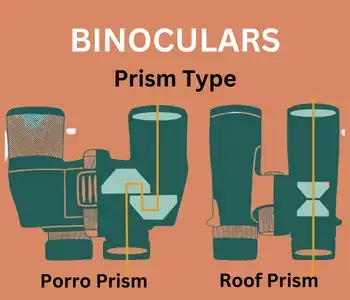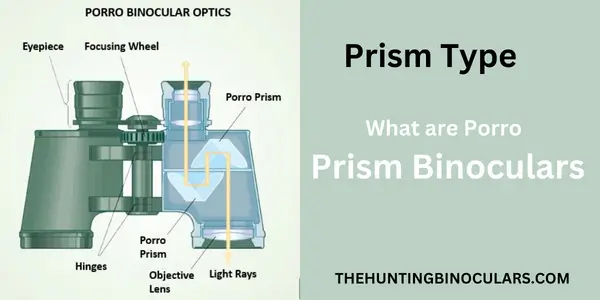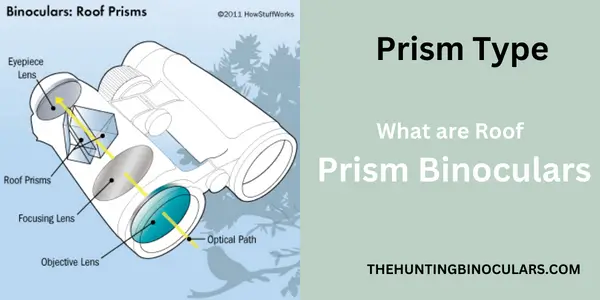
Binocular prisms are optical components used in binoculars, telescopes, microscopes, and other optical instruments. They are used to invert and/or reverse the image in the optical train. This is accomplished by bending light through two right-angle prisms which are joined together. What are binocular prism types?
Porro prisms are the most common type of prism used in binoculars. Porro prisms are easily recognizable by their offset design, with the eyepieces and objective lenses positioned at different heights. Roof prisms are more compact than Porro prisms and have a straight-through design. They are often used in high-end binoculars and provide excellent image quality, but they can be more expensive.
Each type of binocular prism has its advantages and disadvantages, so it’s important to consider your specific needs and fondness when choosing a pair of binoculars.
Table of Contents
Binocular Prism Types | Roof Prism vs Porro Prism | Which One is Better
Let’s go ahead to get detailed information about the types of binocular prisms.
What does a Prism mean
A prism is a solid form that is enclosed by flat surfaces on all of its edges. It has two different kinds of sides. Bases are similar to the top and bottom sides. The term “prism” refers to the form of these foundations. For instance, a prism is referred to be a triangle prism if its bottom is triangular.
The sides of a prism that are not the top and bottom are referred to as its peripheral faces. The category of parallelograms also includes all the side faces and all of them are similar to one another.
Due to the parallel alignment of their different sides, all of the peripheral sides can be either parallelograms, rectangles, or even squares. A cube shape is among the most prevalent examples of a prism. It is known as a rectangular prism and has a rectangle basis.
Why prisms are used in binoculars
- What does a prism mean? Prisms are an integral part of binoculars, as they are responsible for the magnifying and focusing of light.
- Prisms use the refraction of light to focus the light rays and make the object look larger and closer like stargazing binoculars.
- With the help of prisms, binoculars can magnify an object many times over, allowing for clear and detailed images.
- The use of prisms in binoculars also helps to reduce chromatic aberration – a phenomenon that produces color fringing or a rainbow effect around the edges of an image. This makes it easier to focus on the object and get a clearer view.
- Prisms also help to increase the field of view which allows the user to see more of the object.
- Without the use of prisms, binoculars would not be able to magnify images, making them useless for observing objects in the distance.
Main Binocular Prism Types
There are two types of binocular prism:
- Roof prisms
- Porro prisms
What are Roof Prism binoculars
Roof prisms are designed to invert and reverse the image while also maintaining a right-side-up orientation. The prism is made up of two right-angle prisms that are joined together with an angled roof-shaped section between them.

How do Roof Prism Binoculars Work
Roof prism binoculars use two prisms to bend and reflect the light, allowing you to see a magnified image as with bird-watching binoculars. Here’s how the roof prism binoculars work in more detail:
- Light enters the objective lens located at the front of the binoculars for a long distance. The objective lens is a large lens that captures the light and focuses it onto the prisms.
- The light then enters the first prism, called the “roof prism,” which is a long, thin prism with a 90-degree angle.
- The roof prism reflects the light 90 degrees and sends it to the second prism, which is the “eyepiece prism.”
- The eyepiece prism reflects the light again and sends it to the eyepiece lens, which is the lens you look through to see the magnified image.
- The eyepiece lens magnifies the image, making it appear larger than it is.
- The two eyepiece lenses are adjustable to ensure that the distance between the lenses matches the distance between your eyes for eye relief. This is known as the “interpupillary distance.”
- The result is a clear and magnified image of the object you’re looking at.
Advantages of Roof Prism Binoculars
- Roof prism binoculars are lightweight and compact, making them easy to carry and store.
- They have higher-quality optics with improved light transmission for a brighter and sharper image.
- They have a more precise and accurate alignment of the prisms for improved image quality.
- They have erect images and improved depth perception.
- They are less likely to leak light and are more waterproof than Porro Prism binoculars.
- They have fewer internal reflections, resulting in more true-to-life colors and greater contrast.
Disadvantages of Roof Prism Binoculars
Cost of Roof Prism Binoculars
Roof prism binoculars are more expensive than porro prism binoculars due to the more complex design.
Size of Roof Prism Binoculars
Roof prism binoculars are usually smaller and lighter, but they cannot be made as large as porro prism binoculars.
Image Quality
Due to the complexity of the design, roof prism binoculars may have less accurate color reproduction and reduced brightness.
Image Stabilization
Porro prism binoculars are better suited for image stabilization, as their design is more easily adapted for this purpose.
The Durability of Roof Prism Binoculars
Roof prism binoculars are more delicate and prone to damage from impacts than porro prism binoculars.
What are Porro prism binoculars
Porro prism binoculars are a type of optics device used for observation and magnification purposes. They feature a pair of lenses or “prisms” arranged in an offset or “porro” configuration, which creates an image with a 3-dimensional depth of field.

How Do Porro Prism Binoculars Work
Porro prism binoculars are a type of optical device specially designed for viewing distant objects in three-dimensional detail like hunting binoculars. They are composed of two sets of lenses, one set of which is curved, and a porro prism. The curved lenses, which gather light from the object, are aligned with the prism to form an image.
When the light passes through the prism, it is bent at an angle, and the image is reflected in the user’s eyes. This angle of reflection allows for a wider field of view and improved depth perception. Porro prism binoculars are often used for activities such as bird watching, hunting, and astronomy.
Advantages of Porro Prism Binoculars
Porro prism binoculars offer several advantages over other types of binoculars. They are usually less expensive and have superior depth perception and a wider field of view. Additionally, Porro prism binoculars are often more durable and have greater light transmission, providing brighter images with greater clarity.
Furthermore, they are less bulky and more compact than other types of binoculars, making them easier to transport. Finally, Porro prism binoculars maintain image quality even with large magnification, making them ideal for distant viewing.
Other Binocular Prism Types
Binocular prisms are used to correct eye alignment issues and help individuals with conditions such as strabismus or amblyopia. In addition to the most common types of prisms, such as the Pento and Risley prisms, other binocular prism types may be used in certain circumstances. Here are some examples:
Half-pentaprism
A half-pentaprism is a type of prism that combines the properties of a Pento prism and a half-image prism. It is used to correct diplopia, which is double vision.
Maddox prism
A Maddox prism is a type of prism that is used to measure the degree of strabismus or eye misalignment. It is made up of two parallel prisms with the base of one prism facing up and the other facing down.
Lippmann prism
A Lippmann prism is a type of prism that is used in spectrometry to split white light into its component colors. It is made up of a series of mirrors that reflect the light at different angles.
Amici prism
An Amici prism is a type of prism that is used in telescopes and binoculars to reflect light at a 90-degree angle. It is made up of two right-angle prisms that are cemented together.
Dove prism
A Dove prism is a type of prism that is used to invert an image. It is made up of two right-angle prisms that are rotated against each other.
Abbe-Koenig prism
An Abbe-Koenig prism is a type of optical prism used to invert and deviate a beam of light, often used in telescopes and microscopes. The Abbe-Koenig prism is particularly useful for applications where a beam of light needs to be redirected without introducing aberrations or distortions in the image.
Abbe prism
An Abbe prism is a type of optical device that utilizes the refractive properties of prisms to separate light into its component wavelengths. It was named after its inventor, Ernst Abbe, and is most commonly used in microscopy to analyze the intensity of light sources.
When light is passed through the prism, it bends at each angle before exiting the other side, leaving the different wavelengths at separate points along the prism’s surface.
Kutter prism
The Kutter prism is a specialized optical device used to separate light into its spectral components. It is an optical component made up of two triangular prisms, arranged uniquely to disperse light into its component wavelengths.
The prism is used in a variety of applications, including spectroscopy, imaging, and illumination. It is used in the medical field to analyze light for chemical analysis and imaging of body parts.
Pellin-Broca prism
A Pellin-Broca prism is an optical device that splits, reflects, and recombines light waves to separate them into their component colors. It is widely used in spectroscopy, a scientific technique that measures the spectrum of light from a source. Pellin-Broca prisms are also used in many other applications, including photography and astronomy.
Schmidt-Pechan prism: The Schmidt-Pechan prism is an optical device used to deviate the path of light rays with minimal distortion. It is a type of Amici prism, consisting of two right-angled prisms glued together, with a thin section of flint glass between them. The prisms are usually made from high-index glasses such as flint glass and Crown glass, which can bend light more efficiently than lower-index glass, such as BK7.
Rochon prism
A Rochon prism is an optical device that splits light into two beams of different polarization. It is a type of beam splitter consisting of two right-angle prisms cemented together at their hypotenuse faces, with the bisecting prism face rubbed with an opaque material such as soot or lampblack.
Porro Prism Vs Roof Prism Binoculars
Porro prism and roof prism are the two main types of binoculars available in the market, and they differ in several ways, including design, performance, and cost.
- Porro prisms in binoculars have a classic design that consists of a Z-shaped optical path. This design provides a wide field of view and a more natural depth perception. Porro prism binoculars are also generally more affordable than roof prism binoculars.
However, Porro prism binoculars are generally larger and bulkier than roof prism binoculars, making them less convenient to carry around.
- Roof prism binoculars have a more compact and streamlined design, which makes them lighter and easier to handle. They are also more durable and water-resistant than Porro prism binoculars.
Roof prism binoculars are generally more expensive than Porro prism binoculars due to the complexity of their design and manufacturing process. However, they provide a clearer and sharper image, particularly at higher magnification levels.
In summary, if you are looking for a more affordable option with a wider field of view and more natural depth perception, then Porro Prism binoculars may be a good choice. However, if you need a more compact and durable option with a clearer and sharper image, then roof prism binoculars may be a better choice.
Uses of Prism Binoculars
Prism binoculars are optical devices that use prisms to bend and reflect light, allowing the user to see a magnified and clearer image of distant objects. There are several uses of prism binoculars, including:
Bird watching
Prism binoculars are commonly used by bird watchers to observe and identify different species of birds in the wild.
Binoculars Used for Astronomy
Binoculars can be used for stargazing and observing celestial objects, particularly when a telescope is too cumbersome or not available.
Binoculars Used Hunting
Hunters use binoculars to spot and identify a game from a distance, improving their chances of a successful hunt.
Sports and events
Binoculars can enhance the experience of watching sporting events and concerts, providing a closer view of the action on the field or stage.
Binoculars For Traveling
When exploring new places, binoculars can help you to take in the scenery, observe wildlife, and appreciate natural beauty, such as mountains, oceans, and other landscapes.
Surveillance and security
Law enforcement and security personnel use binoculars to monitor and observe areas from a distance, enhancing situational awareness and identifying potential threats.
Overall, prism binoculars are a versatile and valuable tool for a wide range of activities that require a closer look at distant objects.
FAQ’s
Conclusion
Binocular prisms are a crucial component of many optical instruments, including binoculars and cameras. There are several binocular prism types available, each with its unique advantages and disadvantages. Porro prisms are the most common and affordable type, while roof prisms are more compact and lightweight.
Schmidt-Pechan prisms offer a combination of the benefits of Porro and roof prisms, and Abbe-Koenig prisms are highly efficient but more expensive.
So which one is best suited for you? Please drop your choices in the comment box. Thank you!
